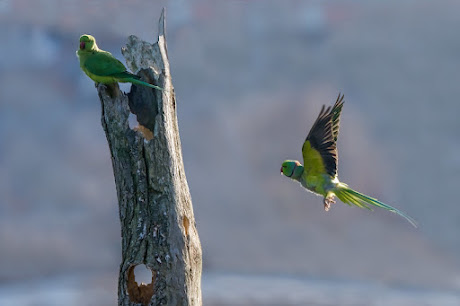A photograph on Flickr of a Ring-necked Parakeet (aka Rose-ringed Parakeet) (Psittacula krameri) taken near Barnsley in Yorkshire by Tim Melling reminded me that I had not commented on a paper that appeared in Journal of Zoology in 2020 on the origins of the large and spreading feral population in Britain. Tim always provides superb captions for his photographs and in this case noted there was more to the origins than was included in that paper.
 |
| Tim Melling's photograph on Flickr showing Ring-necked Parakeets near Barnsley |
The authors of the paper used a statistical technique (‘geographic profiling’) on sighting records to estimate and compare the likely sites of introduction of the founding population(s) with suggestions that have appeared in the press as to where the original releases/escapes occurred. The technique is used apparently in criminal investigations. Needless to say the fabled points of origin did not coincide with the areas of calculated maximum likelihood. The origins of feral populations are often propagated by urban myths usually spread by tabloid journos in need of a story and the Ring-neck Parakeets in Britain are no exception. Two such stories implicate escapees from the set of the film African Queen in 1951 and/or the release in London by somebody called Jimi Hendrix (I had to look him up to find he was an American pop star) in 1968. More prosaic explanations include escapes from private or zoo aviaries and cages (damaged in storms or by falling debris or with corroded wire netting) and pet shops.
Tim concluded the legend for his photograph with:
But Paul Dunham www.flickr.com/photos/183210910@N04/ told me that he worked in a bird garden in the early to mid 1970s and he met many of the biggest bird importers. In his words "They would import 300/500 Ring-necked Parakeets at a time and would house them in aviaries with wooden frames. Of course the Parakeets would gnaw through the wooden frames and escape. I remember four mass escapes which amounted to more than a thousand birds escaping into the English countryside. There were two mass escapes in the London area, one near Cheltenham and another up north in Lancashire I think. These escapes are not hearsay. I heard it from the owners themselves complaining about their losses. I think these mass escapes are the real origins for the British population of Ring-necked Parakeets and not the result of a few pet caged birds escaping over the years”.
Indeed there was some key information lacking in the paper in Journal of Zoology. Yes, there had been reports of escaped Ring-necked Parakeets in Britain but it wasn’t until 1971 that breeding in the wild was first reported (in Kent). The authors of the paper in Journal of Zoology mentioned that the import of all psittacines into Britain was banned from 1930 for two decades. However, they do not mention that the ban, which ended on 7 January 1952, was reimposed on 16 February 1953, not this time because of concern for psittacosis in the human population, but as a precaution against the introduction of poultry diseases. Partial exemption for individuals and zoos etc to import very small numbers of parrots came into force in 1959 but not until 1 November 1966 was the ban lifted completely. Then the floodgates opened. At around that time the number of bird importers in England probably also reached its peak. Thus Ring-necked Parakeets were imported in the numbers described above. Can it be a coincidence that breeding was first observed in 1971? But that mass importation did not go on forever. In 1990 India banned the export of its wild birds. By then though the parakeet had established a population in Britain, estimated in 1986 at 500-1000 individuals.
While major escapes from dealers are the likely explanation (and probably also for its presence in 35 countries to which it is not native on 5 continents) this does not mean that any birds which escaped from aviaries did not find mates in the local concentrations and general dispersal.
One question that remains is whether or not individuals of the African subspecies of the Ring-necked Parakeet were also involved in establishing the populations in UK or other countries. The bird trade from West Africa was in full swing throughout much the 20th century. And how genetically diverse is the UK population? An answer to that question would do much to determine the size of the founder population.
Smaller parakeets, like the domesticated Budgerigar (Melopsittacus undulatus), which have escaped regularly and in fair numbers have not become established in Britain. They easily fall prey to Sparrowhawks. Colonies of the larger Ring-necks are known to mob predators and their large beaks are not to be trifled with. My video taken in Gujarat, below, shows their efforts to see off a nest-raiding rat snake, although the terrific racket they make in doing so falls literally on deaf ears.
And, yes, Ring-necked parakeets have reached deepest Ayrshire. We had one in the garden a few years ago but it did not linger for more than a fe days. Now I read on the Ayrshire Wildlife Facebook page that they are now nesting 20 miles away in a park in Kilmarnock.
Parakeets mob a marauding rat snake
 |
| Female and male Ringnecked-Parakeets in the wild in Sri Lanka Photographed in 2013 |
 |
| ...and two males near Delhi, India, in 2016 |
Heald OJN, Fraticelli C, Cox SE, Stevens MCA, Faulkner SC, Blackburn TM, Le Comber SC. 2020. Understanding the origins of the ring-necked parakeet in the UK. Journal of Zoology 31, 1-11 doi:10.1111/jzo.12753
Prestwich AA. 1967. The parrot ban. Avicultural Magazine 73 (1, January-February 1967), 25-26.
No comments:
Post a Comment